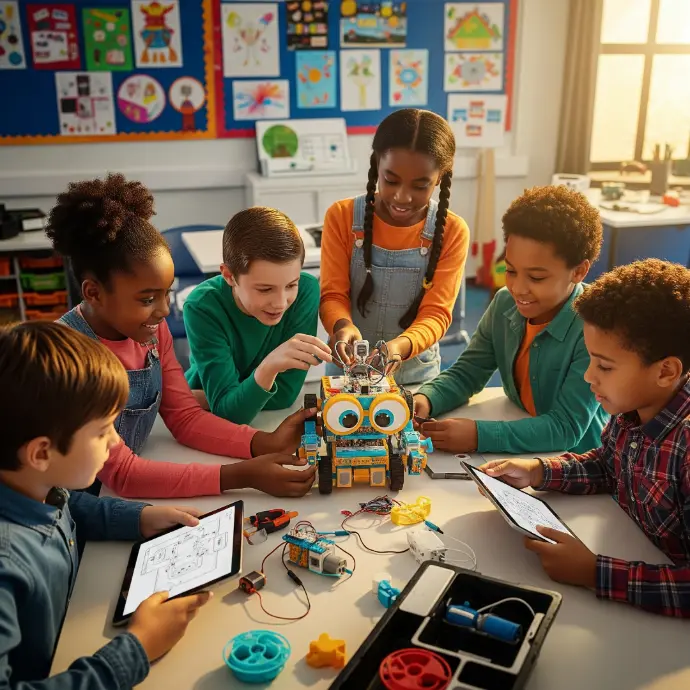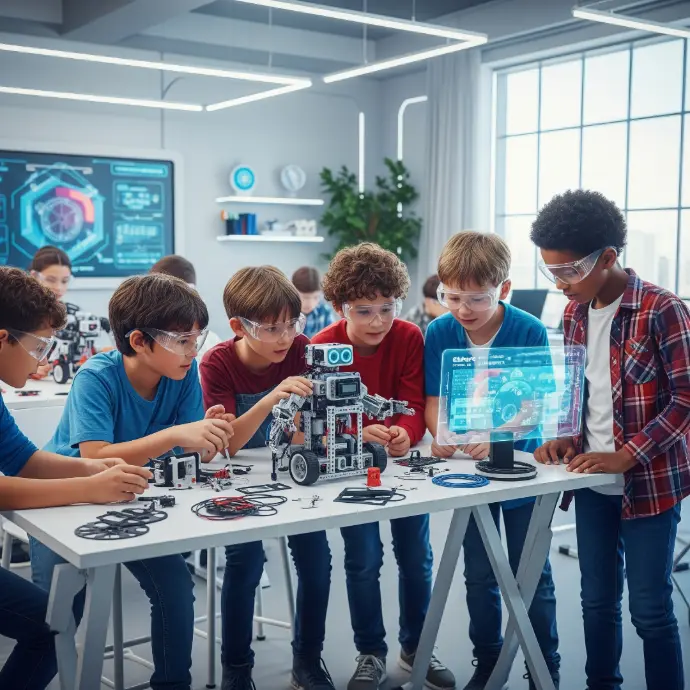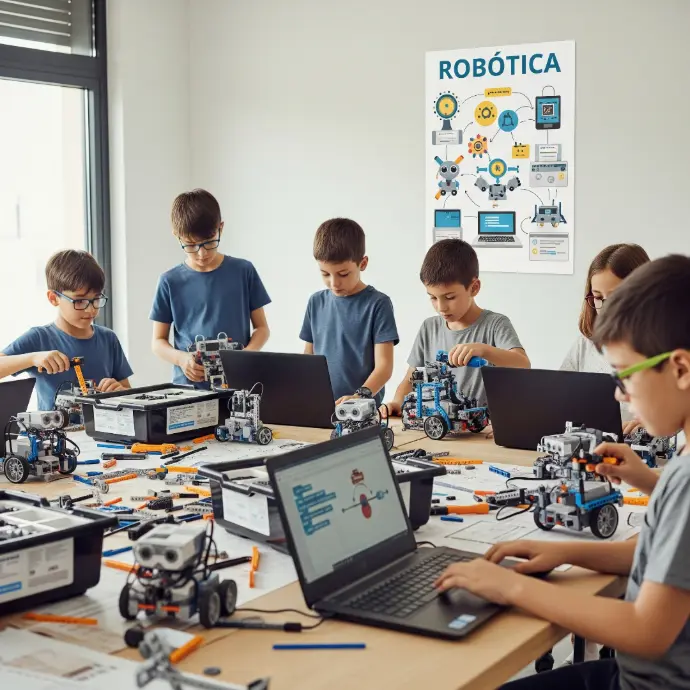Here you'll find a space dedicated to exploring the wonders and challenges of emerging technologies. Our latest article, "Robotics for Kids: Building the Logical Thinking of the Future," will immerse you in the benefits and challenges of introducing little ones to the fascinating world of robotics. Are you ready to discover how this discipline can shape the future of young minds? Keep exploring to uncover all the details!
Introduction to Robotics for Kids
Robotics for kids is an educational discipline that uses building and programming robots as a learning tool. Through hands-on and fun activities, children gain knowledge in areas such as science, technology, engineering, and mathematics (STEM), while developing creative, problem-solving, and logical thinking skills.
Robotics kits for children typically include mechanical parts, sensors, motors, and electronic components, along with software that allows children to program the robots' behavior. These kits are designed to be safe, educational, and entertaining, fostering children's interest in technology from an early age.
Robotics for children is an effective way to introduce complex concepts in an accessible way, promoting hands-on learning and active experimentation.
Robotics education for children is crucial in today's era, where technology plays a pivotal role in all aspects of life. By engaging children in robotics, they are being prepared to understand and confront the technological challenges of the future, as well as to take advantage of emerging opportunities in fields such as artificial intelligence, automation, and programming.
In addition, robotics for children fosters interdisciplinary skills, such as collaboration, communication, critical thinking, and creativity. These skills are essential for success in the 21st century, and robotics education provides an enabling environment for their development.
By acquiring knowledge in robotics, children also become familiar with engineering and design concepts, which can spark vocations in STEM fields and motivate them to pursue technology-related careers in the future.
Participation in robotics activities has a significant impact on the development of children's logical thinking. Through problem-solving and robot programming, children learn to break down complex tasks into logical steps, identify patterns, and think in a structured and analytical manner.
Robotics also promotes perseverance and tolerance for failure, as children experiment with building and programming robots, facing challenges that require focus, creativity, and adaptability. These skills are critical for problem-solving in any area of life.
Robotics not only teaches children about technology but also shapes their way of thinking, preparing them to tackle future challenges with confidence and determination.
The introduction of robotics into early childhood education offers a wide range of benefits for children. First, learning how to program and build robots encourages the development of logical thinking and problem-solving skills. Through experimentation with robots, children acquire skills to plan, test, and adjust their creations, which promotes creativity and innovation from an early age.
Furthermore, robotics provides the opportunity to integrate concepts from math, science, and technology in a practical and fun way. Children can apply knowledge of geometry, physics, and other disciplines to design and program robots, allowing them to visualize the usefulness of these subjects in a stimulating, real-life context. Furthermore, teamwork and collaboration are strengthened by participating in robotics projects, as children must communicate, share ideas, and assign tasks to achieve a common goal.
Finally, introducing robotics into children's education prepares them to face the challenges of tomorrow, giving them important technological skills and familiarizing them with automation and programming concepts, which are crucial in today's digital age. These skills are not only valuable for potential future jobs in technology, but also foster adaptability and critical thinking, key elements for navigating a constantly changing world.

Challenges of Robotics for Children
Teaching robotics to young children can face particular difficulties due to the need to capture their attention and maintain their interest in learning. A common challenge is adapting the content and teaching methods to make them understandable and accessible to children, without losing the essence of the subject. Furthermore, the lack of adequate resources and materials in the educational setting can be a significant obstacle. Finally, teacher training in this area can be insufficient, making the implementation of robotics in the classroom difficult.
Another challenge is promoting equal participation of girls and boys in robotics programs, as there has historically been a gender disparity in STEM fields. It is crucial to create an inclusive environment that encourages everyone to participate equally, regardless of gender.
It is also essential to keep in mind that children may have different skills and experiences with technology, which requires flexible teaching approaches that adapt to the needs of each student.
To address the challenges of teaching robotics to children, it is vital to design educational programs that effectively integrate robotics into the curriculum. This involves training teachers in the use of innovative tools and methods, as well as providing the necessary resources and materials for teaching robotics.
It is also important to encourage collaboration between schools, industry, and the community to ensure access to the technology and support required to run quality robotics programs. Creating creative learning spaces, such as robotics clubs or after-school workshops, can be an effective strategy for motivating children to participate in enriching, hands-on activities.
Including robotics in the classroom can also benefit from the use of online learning platforms, which allow students to explore programming and robotics concepts interactively and independently. These tools can be especially useful in addressing the individual needs of students with different skill levels.
The incorporation of robotics and technology into children's learning can significantly influence children's cognitive growth and problem-solving skills. By participating in robotics-related activities, children have the opportunity to strengthen their logical thinking, mathematical skills, and understanding of scientific concepts.
Likewise, robotics fosters the development of social skills, such as collaboration, imagination, and problem-solving, which are essential today and in the future. By facing practical challenges, children can apply what they have learned in a real-life setting, helping to deepen their understanding of the subject matter.
Robotics for children provides significant benefits in terms of cognitive growth, technical skills, and social skills, thus preparing future generations to address technological challenges and contribute innovatively to the progress of society.
Robotics for children is key to developing critical thinking and problem-solving skills. When children face building and programming challenges, they have the opportunity to learn to identify difficulties, propose solutions, and test their ideas to verify their effectiveness. This approach promotes analysis, creativity, and determination—essential skills for facing future challenges.
Through interaction with robots and participation in programming activities, children learn to think logically and orderly, allowing them to solve problems in a structured manner and find solutions effectively. This skill of abstraction and logical reasoning is essential in an increasingly technological world, where the ability to solve complex problems is highly valued.
Furthermore, by engaging in robotics projects, children develop skills to collaborate, communicate effectively, and manage their time, which benefits their personal growth and prepares them for future challenges in their academic and professional fields.

Robotics as an Educational Tool
Robotics has emerged as an effective educational resource for teaching STEM (Science, Technology, Engineering, and Mathematics) skills to young children. Using robotics, children can understand complex ideas in a playful and hands-on way, helping them improve their problem-solving, critical thinking, and creativity skills. Including robotics in the classroom offers children the opportunity to put theoretical knowledge into practice by building and programming robots, which facilitates deeper and more lasting learning.
Furthermore, robotics promotes collaboration, as children tend to work in teams to design, build, and program their robots, which helps them develop communication, teamwork, and leadership skills. Likewise, early introduction to robotics can inspire children to pursue careers in STEM fields, preparing them to face future challenges and seize opportunities in an increasingly digital world.
Among the various applications of robotics in early childhood education are participating in robotics competitions, creating projects that combine robotics with other disciplines, and solving real-life problems by building and programming robots.
Robotics plays a key role in developing logical thinking in children. When building and programming robots, children must plan, organize, and carry out a series of actions in a logical and orderly manner. This process of following a sequence to achieve a particular goal helps improve their logical reasoning skills and their ability to solve problems in an orderly manner.
Additionally, robotics fosters the ability to abstract, as children need to recognize patterns, establish rules, and create connections between different ideas for robots to perform various tasks. This ability to abstract and generalize is essential for the development of logical and mathematical thinking, skills that are fundamental for future educational and professional success.
Robotics also encourages creativity by challenging children to come up with innovative solutions while programming robots, giving them the opportunity to explore various strategies and methods for solving problems, enriching their logical and creative thinking.
The benefits that robotics brings to children's comprehensive development are numerous. In addition to strengthening logical thinking, robotics helps develop social skills, such as teamwork, collaboration, and effective communication. These skills are essential for achieving personal and professional success today.
Likewise, robotics stimulates creative problem-solving, which nurtures children's innovative capacity and prepares them to face future challenges. At the same time, early exposure to robotics can increase children's confidence in their ability to solve complex problems, which in turn boosts their self-esteem and motivation to learn.
Robotics for children offers a wide range of benefits that go beyond learning technical skills, positively impacting their cognitive, social, and emotional development, and preparing them for a future full of possibilities in a technology-driven world.
Robotics for children plays a key role in fostering motivation and interest in science and technology. By participating in building and programming robots, children can directly experience concepts of engineering, mathematics, physics, and technology in a fun and hands-on way. This immersive experience not only helps them better understand these concepts but also stimulates their curiosity and creativity, cultivating a love of learning in these areas.
Furthermore, by facing challenges and solving problems while building and programming robots, children acquire problem-solving, critical thinking, and teamwork skills. These skills are essential in the present and future, where technology plays an increasingly important role in all areas of life and work.
Robotics for children also has the potential to help close the gender gap in science and technology, as it gives girls the opportunity to participate in activities that have traditionally been dominated by boys. By providing an inclusive and supportive environment, robotics can motivate more girls to explore careers in STEM (science, technology, engineering, and mathematics) fields, which is crucial for achieving equitable representation in these fields.
Robotics for Children: Advantages and Challenges
Incorporating robotics into children's education has proven to be a valuable resource for fostering STEM (Science, Technology, Engineering, and Mathematics) skills. By building and programming robots, children gain hands-on experience in these areas in a fun and engaging way. Problem-solving skills, logical reasoning, creativity, and teamwork skills are just some of the competencies that are strengthened by exploring robotics from an early age.
Furthermore, robotics provides children with the opportunity to apply math and science concepts in real-world situations, giving them a stronger and more relevant understanding of these subjects. This creates a solid foundation for future studies and careers in science and technology-related fields.
In a world that increasingly relies on technology, it is vital to foster these skills from childhood to prepare new generations for the challenges ahead.
Robotics not only supports the development of technical and scientific skills, but is also an excellent way to stimulate children's creativity. By creating and programming robots, children can let their imaginations run wild, designing original solutions to the problems they encounter.
The opportunity to experiment, test, and modify designs and programs in a hands-on way allows children to explore a wide variety of options and responses. This freedom to create and solve problems in their own unique ways boosts their creativity, increasing their self-confidence and ability to innovate.
Likewise, robotics fosters a way of learning based on experimentation and discovery, which results in greater interest and enthusiasm on the part of children in their educational process.
Despite the many benefits of teaching robotics, it also brings with it emotional and social challenges that must be considered. Some children may experience frustration when faced with difficult problems or when their robots do not work as expected. It is crucial that educators be prepared to help students manage their frustration and develop perseverance.
Furthermore, collaboration and teamwork are key elements in robotics education. Children need to learn to communicate, negotiate, and share tasks to achieve common goals. Fostering social and emotional skills, such as empathy, active listening, and conflict resolution, is vital to ensuring a positive and nurturing learning environment.
Teachers play an essential role in helping children face these challenges by creating an inclusive environment filled with mutual respect and emotional support. Focusing on these aspects ensures that robotics education is a complete experience that contributes to children's holistic development.
Diversity and inclusion in robotics education are crucial to ensuring that all children can participate in this fascinating discipline. Robotics for children not only provides advantages in learning technical skills but also stimulates logical thinking, problem-solving, and creativity. By fostering inclusion and diversity, all children, regardless of gender, ethnicity, or economic status, are empowered to explore and cultivate their interest in technology and engineering.
Furthermore, fostering inclusion and diversity in robotics education helps create an environment that values different perspectives and experiences. This can result in greater innovation and creativity in the robotics field, as it promotes the exchange of ideas among students with diverse backgrounds and experiences. Furthermore, by allowing children to be exposed to diversity from an early age, it lays the foundation for a future where collaboration and teamwork are more inclusive and effective.
Finally, diversity and inclusion in robotics education can help challenge gender and social stereotypes, demonstrating that technology and engineering are open to all. By providing equitable opportunities in robotics learning, it helps create a new generation of thinkers and creators who reflect the diversity of society and are ready to face the challenges of the future.

The Future of Robotics in Education
Robotics education for children has seen a considerable increase in recent years. Current trends in education indicate that robotics is being incorporated as a key tool for developing logical reasoning and problem-solving. Through programming and assembling robots, children have the opportunity to learn technological skills that will be crucial in the future.
Robotics for children is not limited to the creation of simple robots; it also encompasses topics such as artificial intelligence, machine learning, and complex programming. This offers children the opportunity to learn advanced technologies from an early age, thus laying a foundation for better understanding and use in their academic and professional lives.
Furthermore, robotics education fosters creativity, teamwork, and critical thinking, as children must devise, build, and program solutions to specific problems. This provides them with valuable hands-on experience to face real-world challenges.
The arrival of robotics in education has the power to change the way children learn and connect with technology. By adding robotics to the curriculum, it can improve understanding of math and science concepts, as well as promote computational thinking and practical problem-solving. This prepares students for future studies in STEM (Science, Technology, Engineering, and Mathematics) fields, giving them a solid foundation for careers in technology-based sectors.
Furthermore, robotics supports interdisciplinarity by combining diverse areas of knowledge, which favors a more comprehensive education and the development of students with an adaptive perspective in the face of rapid technological advances.
Integrating robotics into the educational process has the potential to transform the way children learn and develop skills, adequately preparing them for a future driven by technology.
Robotics plays an essential role in preparing young people for the future of work, which will increasingly focus on technology and automation. By learning about robotics and programming, children acquire skills that will be useful in careers in engineering, computer science, artificial intelligence, and robotics. These competencies will give them an advantage in an ever-changing job market, where the need for technology experts will continue to grow.
Furthermore, robotics stimulates creativity and original thinking, skills that are highly valued in jobs that require unique ideas and innovative solutions. This helps children confidently face job challenges and gives them the necessary tools to adapt to new technologies and different work environments in the future.
Incorporating robotics into learning not only supports children's educational development but also prepares them for a dynamic and competitive job market, where technological skills will be crucial for professional success.
Conclusion
The inclusion of robotics in early childhood education has had a remarkable impact on children's skill development. By building and programming robots, children not only learn about science, technology, engineering, and mathematics (STEM), but also improve their logical thinking, creativity, problem-solving skills, and teamwork.
Likewise, robotics stimulates curiosity and interest in technological innovations, preparing children for the challenges of the future. This educational tool offers them a practical understanding of abstract ideas, allowing them to apply what they know in concrete situations, which promotes their cognitive growth and critical thinking skills.
Children's robotics not only boosts STEM learning but also supports the full development of the skills necessary to face the challenges of the 21st century.
The successful integration of robotics in education requires careful planning and a precise understanding of educational objectives. It is essential that teachers receive training in the use of educational robotics and are able to efficiently incorporate it into the curriculum.
Additionally, it is vital to provide a learning environment that promotes experimentation, error, and discovery. Children should have the opportunity to independently research, create, and learn about robotics, allowing them to naturally develop problem-solving and critical thinking skills.
Finally, it is essential to remember that robotics does not replace other teaching methods, but rather complements them and enriches the educational process. By incorporating robotics appropriately, children's learning can be enhanced and prepared for a technology-driven future.

 IHRO NEWS
IHRO NEWS